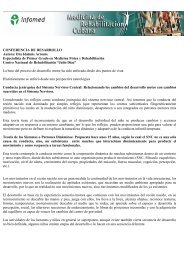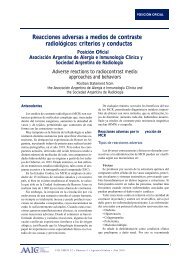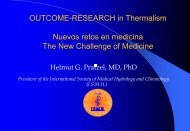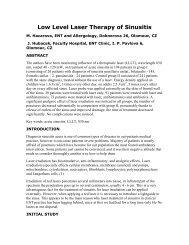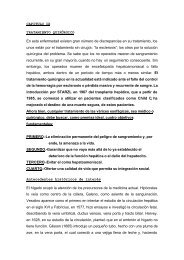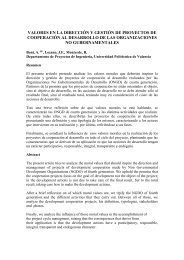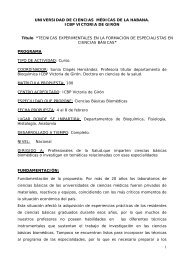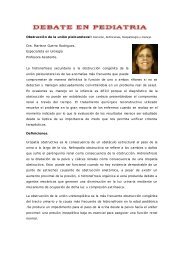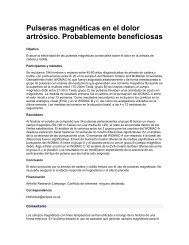Comparison ofthree facebow/semi-adjustable articulator systems for ...
Comparison ofthree facebow/semi-adjustable articulator systems for ...
Comparison ofthree facebow/semi-adjustable articulator systems for ...
You also want an ePaper? Increase the reach of your titles
YUMPU automatically turns print PDFs into web optimized ePapers that Google loves.
British Journal of Oral and Maxillofacial Surgery (2000) 38, 185–190<br />
© 2000 The British Association of Oral and Maxillofacial Surgeons<br />
doi:10.1054/bjom.1999.0182<br />
BRITISH JOURNAL OF ORAL & MAXILLOFACIAL SURGERY<br />
<strong>Comparison</strong> of three <strong>facebow</strong>/<strong>semi</strong>-<strong>adjustable</strong> <strong>articulator</strong> <strong>systems</strong> <strong>for</strong><br />
planning orthognathic surgery<br />
A. M. O’Malley, A. Milosevic*<br />
Hospital Orthodontic Practitioner, Orthodontic Department; *Consultant in Restorative Dentistry, Liverpool<br />
University Dental Hospital, Liverpool, UK<br />
SUMMARY. Our aim was to measure the steepness of the occlusal plane produced by three different <strong>semi</strong><strong>adjustable</strong><br />
<strong>articulator</strong>s: the Dentatus Type ARL, Denar MkII, and the Whipmix Quickmount 8800, and to assess<br />
the influence of possible systematic errors in positioning of study casts on <strong>articulator</strong>s that are used to plan<br />
orthognathic surgery. Twenty patients (10 skeletal class II, and 10 skeletal class III) who were having pre-surgical<br />
orthodontics at Liverpool University Dental Hospital were studied. The measurement of the steepness of the<br />
occlusal plane was taken as the angle between the <strong>facebow</strong> bite-<strong>for</strong>k and the horizontal arm of the <strong>articulator</strong>. This<br />
was compared with the angle of the maxillary occlusal plane to the Frank<strong>for</strong>t plane as measured on lateral<br />
cephalometry (the gold standard). The Whipmix was closest to the gold standard as it flattened the occlusal plane by<br />
only 2° (P
186 British Journal of Oral and Maxillofacial Surgery<br />
Table 1 – Areas of model surgery facilitated by a <strong>semi</strong>-<strong>adjustable</strong><br />
<strong>articulator</strong><br />
Checking validity of planned bone cuts and magnitude of<br />
movements including autorotation of the mandible;<br />
Practising the osteotomy cuts;<br />
Assessing outcome in terms of dynamic occlusion and<br />
aesthetics;<br />
Construction of intermediate and final interpositional acrylic<br />
wafers to check that surgical movements match planned<br />
movements.<br />
simple-hinge <strong>articulator</strong> (such as the Galetti) as<br />
opposed to a <strong>semi</strong>-<strong>adjustable</strong> type (such as the Hanau)<br />
resulted in an antero-posterior error of 2 mm on the<br />
Galetti and 0.2 mm on the Hanau. 11<br />
Accuracy of model surgery, construction of<br />
splints 13–15 and the <strong>articulator</strong> <strong>systems</strong> (calliper plat<strong>for</strong>m,<br />
16 reverse surgical sequencing 17 ) have all been<br />
described previously. The most cited model surgery<br />
techniques are the ‘Lockwood key-spacer system’ 18 and<br />
‘The Eastman Technique’. 19 Bamber et al. (A comparative<br />
study of two orthognathic model surgery techniques.<br />
Paper presented at the British Society <strong>for</strong><br />
Dental Research, 1996) compared the accuracy of<br />
these two techniques using duplicate casts of 15<br />
patients with different malocclusions requiring Le<br />
Fort I osteotomy planned on the Denar Mark II <strong>articulator</strong>.<br />
They found neither technique to be absolutely<br />
accurate, but the Eastman technique was significantly<br />
better <strong>for</strong> vertical and anteroposterior movements.<br />
Model surgery is subject to discrepancies; significant<br />
differences between planned and surgical jaw<br />
movements can result from the difference between the<br />
true and simulated centres of mandibular rotation as<br />
well as from the erroneous transfer of reference lines<br />
and points between model surgery and operation. 20<br />
The centre of autorotation is likely to be posterior and<br />
inferior to the centre of the condyle, 21 and there<strong>for</strong>e<br />
autorotation is difficult to mimic on an <strong>articulator</strong><br />
that rotates around its metallic condyle and not<br />
around a point posterior and inferior to it.<br />
We aimed to investigate possible differences in<br />
anteroposterior steepness (cant of the occlusal plane)<br />
between three <strong>semi</strong>-<strong>adjustable</strong> <strong>articulator</strong>s, whether<br />
differences in skeletal pattern have any influence on<br />
the steepness of the occlusal plane, and finally<br />
whether these differences affect the surgical planning<br />
<strong>for</strong> maxillary or mandibular osteotomies. Local ethics<br />
committee approval was given.<br />
SUBJECTS AND METHODS<br />
Patients who were to have orthognathic presurgical<br />
assessment were invited to participate in the clinical<br />
study at the Liverpool University Dental Hospital’s<br />
department of orthodontics (Table 3). The inclusion<br />
criteria were patients who required correction of their<br />
skeletal class II or III malocclusion by osteotomy;<br />
either a recent lateral cephalometric radiography (at<br />
beginning or end of presurgical orthodontics) or the<br />
Table 2 – Indications <strong>for</strong> types of <strong>articulator</strong> <strong>for</strong> various osteotomy<br />
procedures 11<br />
Simple-hinge adequate:<br />
• Mandibular advancement, set-back, or subapical surgery;<br />
• Maxillary subapical surgery (where no change in the vertical<br />
plane of space is proposed);<br />
• Maxillary transverse expansion or contraction (subject to the<br />
following constraints):<br />
• Anterior and vertical orientation of the anterior maxilla is<br />
assessed first by cephalometric measurements;<br />
• Feasibility of mandibular autorotation is studied first by<br />
cephalometric measurements;<br />
• Maxillary occlusal plane is not canted appreciably;<br />
• Tripod occlusal stability exists between the maxillary and<br />
mandibular models (no large edentulous spaces will prevent<br />
proper model orientation).<br />
Semi-<strong>adjustable</strong> indicated:<br />
• When the case fails to satisfy any of the constraints listed above;<br />
• Maxillary impaction and mandibular autorotation;<br />
• Fabrication of an intermediate splint;<br />
• To ensure coincidence of dental and facial midlines;<br />
• Mandibulofacial asymmetries;<br />
• When excursions of the proposed occlusion are to be studied.<br />
Table 3 – Study sample group of patients be<strong>for</strong>e orthognathic<br />
procedures<br />
Sex No. of Age (years) Skeletal pattern<br />
patients<br />
Mean (SD) Class II Class III<br />
Male 7 20.9 (6.7) 5 2<br />
Female 13 19.5 (6.6) 5 8<br />
Total 20 20.0 (6.5) 10 10<br />
need <strong>for</strong> a future film <strong>for</strong> surgical planning and there<strong>for</strong>e<br />
no need <strong>for</strong> additional radiography and written<br />
consent.<br />
Patients who had already been operated on, had<br />
facial asymmetry, or who had inadequate clinical<br />
records were excluded. The sample was recruited from<br />
sequential patients taken from the waiting list <strong>for</strong><br />
treatment, or from those attending orthognathic planning<br />
clinics at the end of presurgical orthodontics,<br />
and had, by definition, severe skeletal class II or III<br />
de<strong>for</strong>mities.<br />
The three <strong>facebow</strong>s studied were the Denatus type<br />
ARL (Denatus International, Hagersten, Sweden),<br />
the Denar Mask II (Denar Corporation, Anaheim,<br />
Cali<strong>for</strong>nia, USA), and the Whipmix Quickmount<br />
8800 (Whipmix, Louisville, Kentucky, USA). Each<br />
<strong>facebow</strong> was registered in turn according to the manufacturer’s<br />
instructions. The operator (AO’M) was<br />
trained in all three types by an experienced restorative<br />
dentist (AM) to ensure that his technique was correct.<br />
All records <strong>for</strong> each subject were completed on the<br />
same day by the same operator.<br />
Each <strong>facebow</strong> was mounted on to its respective<br />
<strong>articulator</strong>, which was placed on an optically levelled<br />
plat<strong>for</strong>m. This was done by placing two bubble gauges<br />
at right angles to each other, ensuring that the <strong>articulator</strong><br />
base (lower arm) and upper arm were parallel<br />
with the true horizontal. This allowed measurement<br />
of the maxillary occlusal plane angle by putting the
Rabone angle setter (Rabone, England) on a custommade<br />
80-mm extension to the bite-<strong>for</strong>k (Figs 1&2).<br />
This was made of 12 mm square aluminum with a<br />
centric core drilled to fit over the bite-<strong>for</strong>ks as a sleeve<br />
with a line scored parallel with its longitudinal axis.<br />
The upper arm of the <strong>articulator</strong> was also levelled at<br />
true horizontal using a small spirit level.<br />
Measurements<br />
The angle between the bite-<strong>for</strong>k and the upper <strong>articulator</strong><br />
arm was measured to indicate the steepness of<br />
the maxillary occlusal plane. The upper <strong>articulator</strong><br />
arm was horizontal and there<strong>for</strong>e parallel to the<br />
Frank<strong>for</strong>t plane. The angle between the bite-<strong>for</strong>k<br />
extension and the upper <strong>articulator</strong> arm was measured<br />
with a Robone angle setter positioned on the<br />
extension. The angle setter is based on the principle of<br />
a bubble-gauge within a rotating core to an angular<br />
scale.<br />
Cephalometric analysis<br />
Cephalometric tracing done by hand on fine acetate<br />
sheets in a darkened room by the same operator who<br />
did the clinical study. The angle on the cephalogram<br />
that reproduced the angle measured clinically on the<br />
<strong>articulator</strong> was Frank<strong>for</strong>t plane to maxillary occlusal<br />
plane (Fp/MOP). The Frank<strong>for</strong>t plane is a line<br />
between the machine porion and orbitale, and the<br />
maxillary occlusal plane is between first molar<br />
mesiobuccal cusp and the incisor edge.<br />
Statistical analysis<br />
The significance of differences between measurements<br />
was assessed using the Statistical Package <strong>for</strong> the<br />
Social Sciences software (SPSS) on the University of<br />
Liverpool Unix system. Continuous data were<br />
analysed by the appropriate parametric test.<br />
Differences between groups were analysed by one-way<br />
analysis of variance (ANOVA).<br />
Error of the method<br />
A random selection of five out of the 20 cases had<br />
their measurements repeated to establish the SE of the<br />
method. This was done by removing the <strong>facebow</strong>s<br />
from their <strong>articulator</strong>s and re-mounting them 24<br />
hours later to repeat readings. The cephalograms were<br />
also retraced <strong>for</strong> these subjects to test reproducibility.<br />
RESULTS<br />
Three <strong>facebow</strong>/<strong>semi</strong>-<strong>adjustable</strong> <strong>articulator</strong> <strong>systems</strong> 187<br />
Fig. 1 – Whipmix <strong>facebow</strong> and <strong>articulator</strong> on levelled plat<strong>for</strong>m<br />
with Rabone angle setter measuring the steepness of the occlusal<br />
plane regulated by the bite-<strong>for</strong>k extension. Fig. 2 – Photograph of the custom-made bite-<strong>for</strong>k extension with<br />
nylon fixing screw.<br />
Twenty patients were recruited to the study, 10 in each<br />
surgical category of skeletal class II and III (Table 3).<br />
The mean time lapse between the pre-orthodontic<br />
treatment radiography and collecting <strong>facebow</strong> records<br />
was 3.2 months (range 1–7) but the interval between<br />
commencement of orthodontic treatment and taking<br />
<strong>facebow</strong> records was one month.<br />
The anteroposterior and vertical skeletal parameters<br />
are presented individually <strong>for</strong> skeletal classes II<br />
and III in Table 4. Most patients required bimaxillary<br />
procedures to correct their skeletal disproportion and<br />
malocclusion (Table 5). Only two patients could be<br />
treated by mandibular surgery alone.<br />
The angle between occulusal plane measured from<br />
bite-<strong>for</strong>k extension to upper <strong>articulator</strong> arm was compared<br />
with the traced Frank<strong>for</strong>t plane to maxillary<br />
occlusal plane angle. The ‘gold standard’ was there<strong>for</strong>e<br />
the cephalometric angle, which <strong>for</strong> the group was<br />
14.6° with a relatively large SD (Table 6).<br />
Table 4 – Mean (SD) orthodontic and skeletal measurements (°)<br />
made on cephalograms (n = 10 in each group)<br />
Angle Skeletal II Skeletal III<br />
ANB 6 (2.9) –4.6 (2.8)<br />
FMPA 35.7 (9.9) 36.5 (7.4)<br />
MMPA 32.1 (8.2) 28.8 (4.3)
188 British Journal of Oral and Maxillofacial Surgery<br />
Table 5 – Categories of operation by skeletal pattern (numbers of<br />
patients in each group)<br />
Category Skeletal II Skeletal III<br />
Maxilla only 1 1<br />
Mandible only 2 0<br />
Bimaxillary 7 9<br />
Total 10 10<br />
The mean angle <strong>for</strong> the Whipmix <strong>articulator</strong> group<br />
came closest to the gold standard, meaning that the<br />
Whipmix tended to position the maxillary occlusal<br />
plane almost 2° shallower than on the cephalogram.<br />
This was significantly different from the gold standard<br />
(P
Table 7 – Effect of vertical skeletal pattern on steepness of occlusal<br />
plane<br />
Vertical No. of patients<br />
skeletal pattern Skeletal II Skeletal III Mean Fp/MOP (°)<br />
Low 1 0 9.0<br />
Medium 5 4 9.6<br />
High 4 6 19.8*<br />
Total<br />
* P
190 British Journal of Oral and Maxillofacial Surgery<br />
during which the ramus remains intact is that, because<br />
the centre of autorotation of the mandible is<br />
unchanged, autorotation leads to premature contact<br />
anteriorly with a tendency <strong>for</strong> a posterior open-bite. It<br />
is apparent that most of the inaccuracies described are<br />
small and may not be clinically relevant.<br />
The relevance of correct replication of the angle on<br />
the <strong>articulator</strong> has consequences on maxillary movements<br />
and mandibular autorotation. This has not previously<br />
been reported to our knowledge. The concept<br />
of validating the position of study casts on an <strong>articulator</strong><br />
is a relatively new one. 25 Whatever <strong>articulator</strong><br />
clinicians use, we encourage them to check the accuracy<br />
of mounted study casts, in particular the steepness<br />
of the occlusal plane, be<strong>for</strong>e the technician makes<br />
the model.<br />
Acknowledgements<br />
The Denar instrumentation used was supplied by Prestige Dental,<br />
Brad<strong>for</strong>d, UK. We thank Mr G. Abbott in the engineer’s workshop,<br />
Liverpool University Dental Hospital, who custom-made the bite<strong>for</strong>k<br />
extension. Valuable orthodontic and orthognathic planning<br />
advice was provided by Mr S.J. Rudge, Consultant Orthodontist.<br />
References<br />
1. Beyron H. Orienterings problem vid protetiska<br />
rekonstruktioner och bettstudier. Svensk Tandlakara Tidskrift<br />
1942;35:1–55.<br />
2. Schallhorn RG. A study of the arbitrary centre and the<br />
kinematic centre of rotation <strong>for</strong> <strong>facebow</strong> mountings. J<br />
Prosthet Dent 1957;7:162–169.<br />
3. Weinberg LA. An evaluation of the <strong>facebow</strong> mounting. J<br />
Prosthet Dent 1961;11:32–42.<br />
4. Teteruck WR, Lundeen HC. The accuracy of an ear <strong>facebow</strong>.<br />
J Prosthet Dent 1966;16:1039–1046.<br />
5. Gonzales JB, Kingery RH. Evaluation of planes of reference<br />
<strong>for</strong> orienting maxillary casts on <strong>articulator</strong>s. J Am Dent Assoc<br />
1968;76:329–336.<br />
6. Bailey JO, Nowlin TP. Accuracy of the Frank<strong>for</strong>t plane<br />
transfer of the Hanau <strong>articulator</strong>. J Dent Res 1981;60(special<br />
issue): Abstract 885;531.<br />
7. Gold BR, Setchell DJ. An investigation of the reproducibility<br />
of <strong>facebow</strong> transfers. J Oral Rehabil 1983;10:495–503.<br />
8. Bowley JF, Michaels GC, Lai TW, Lui PP. Reliability of a<br />
<strong>facebow</strong> transfer procedure. J Prosthet Dent 1992;67:491–498.<br />
9. Palik JF, Nelson DR, White JT. Accuracy of an earpiece<br />
<strong>facebow</strong>. J Prosthet Dent 1985;53:800–804.<br />
10. Goska JR, Christensen LV. <strong>Comparison</strong> of cast positions by<br />
using four <strong>facebow</strong>s. J Prosthet Dent 1988;59:42–44.<br />
11. Marko JV. Simple hinge and <strong>semi</strong>-<strong>adjustable</strong> <strong>articulator</strong>s in<br />
orthognathic surgery. Am J Orthod Dentofacial Orthop<br />
1986;90:37–44.<br />
12. Proffit WR, White RP Jr. Surgical orthodontic treatment. St<br />
Louis: CV Mosby, 1991.<br />
13. Ellis E. Modified splint design <strong>for</strong> two-jaw surgery. J Clin<br />
Orthod 1982;16:619–622.<br />
14. Wong BW. Innovations in orthognathic splint construction. J<br />
Clin Orthod 1985;19:750–756.<br />
15. Shwestka R, Engelke D, Zimmer B, Kubein-Meesenburg D.<br />
Positioning control of the upper incisors in orthognathic<br />
surgery. Eur J Orthod 1991;13:367–371.<br />
16. Ellis E. Accuracy of model surgery: evaluation of an old<br />
technique and introduction of a new one. J Oral Maxillofac<br />
Surg 1990;48:1161–1167.<br />
17. Cottrell D, Wol<strong>for</strong>d LM. Altered orthognathic surgical<br />
sequencing and a modified approach to model surgery. J Oral<br />
Maxillofac Surg 1994;52:1010–1020.<br />
18. Lockwood H. A planning technique <strong>for</strong> segmental<br />
osteotomies. Br J Oral Surg 1974;12:102–105.<br />
19. Anwar M, Harris M. Model surgery <strong>for</strong> orthognathic<br />
planning. Br J Oral Maxillofac Surg 1990;28:393–397.<br />
20. Nattestad A, Vedtofte P. Pitfalls in orthognathic model<br />
surgery. Int J Oral Maxillofac Surg 1994;23:11–15.<br />
21. Nattestad A, Vedtofte P. Mandibular autorotation in<br />
orthognathic surgery: a new method of locating the centre of<br />
mandibular rotation and determining its consequence in<br />
orthognathic surgery. J Cranio Maxillofac Surg<br />
1992;20:163–170.<br />
22. Pitch<strong>for</strong>d JH. A re-evaluation of the axis-orbital plane and the<br />
use of orbitale in a <strong>facebow</strong> transfer record. J Prosthet Dent<br />
1991;66:349–355.<br />
23. Sassouni V. The Face in Five Dimensions, 2nd edn.<br />
Morgantown: West Virginia University School of Dentistry<br />
Publications, 1962.<br />
24. Hohl TH. The use of an anatomical <strong>articulator</strong> in segmental<br />
orthognathic surgery. Am J Orthod Dentofac Orthoped<br />
1978;73:428–442.<br />
25. Omura T, Glickman RS, Super S. Method to verify the<br />
accuracy of model surgery and prediction tracing. Int J Adult<br />
Orthod Orthognath Surg 1996;11:265–270.<br />
The Authors<br />
A. M. O’Malley MDentSci, FDSRCS, MOrthRCS<br />
Hospital Orthodontic Practitioner<br />
A. Milosevic PhD, FDSRCS, DRDRCS<br />
Consultant in Restorative Dentistry<br />
Orthodontic Department<br />
Liverpool University Dental Hospital<br />
Liverpool, UK<br />
Correspondence and requests <strong>for</strong> offprints to: Dr A. Milosevic,<br />
Department of Clinical Dental Sciences, School of Dentistry,<br />
University of Liverpool, Liverpool L69 3BX, UK. Tel: +44 (0)151<br />
706 5221; Fax: +44 (0)151 706 5845; E-mail: a.milosevic@liv.ac.uk<br />
Paper received 29 December 1998<br />
Accepted 12 March 1999




